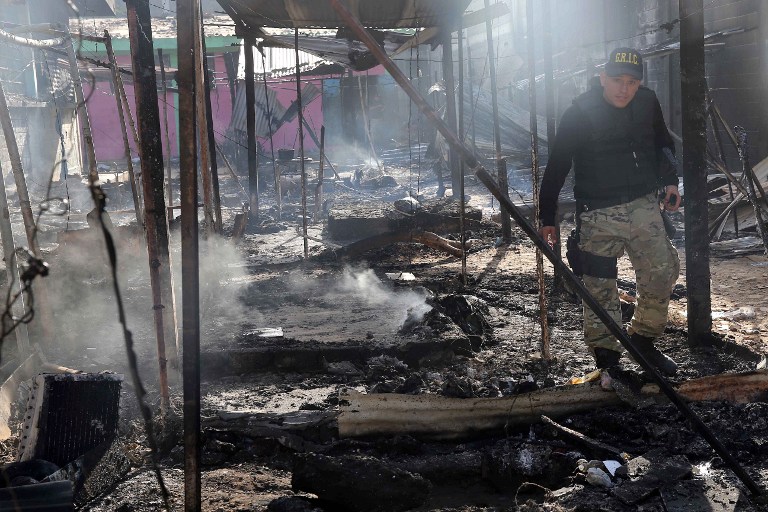
The aftermath of a deadly prison riot in Lara state, Venezuela in 2013.
“Its fugitive leader, “El Niño” Guerrero, benefited from complicity and even negotiated with the government to leave the prison before the security operation began, according to the NGO Venezuelan Prison Observatory.”
The Maduro regime in Venezuela recently conducted a military operation in the Tocorón prison, the power center of the transnational Tren de Aragua criminal network.[i] According to the excerpted article from the Argentine outlet Infobae, the regime uncovered a large stockpile of weapons and munitions at the prison, including anti-tank launchers, artillery rockets, and a cache of rifles and pistols. Additionally, the article reports that prisoners controlled a small town where family members lived, replete with amenities such as a pool, baseball stadium, and zoo. This level of criminal control is common in Venezuela, where the Maduro regime has relied on prison gang leaders, called “pranes,” to maintain a semblance of stability and control, and to reduce violent prison uprisings.[ii] In exchange, groups like the Tren de Aragua possess a high degree of autonomy within prison walls to continue criminal activity. In reasserting state control over the Tocorón prison, the Maduro regime claims to have defeated Tren de Aragua, as reported by Colombia’s center-left daily El Espectador. There are many reasons to doubt this claim notably, Tren de Aragua’s leader, Héctor Guerrero Flórez (alias “Niño Guerrero”), escaped before the raid with forewarning about an impending operation. Despite this, the Maduro regime’s military operation is significant for a few reasons. First, it allows the Maduro regime to claim that it is addressing the complaints of its neighbors in the region, who have openly fretted about the regional growth of the Tren de Aragua criminal network. Second, the operation could pay domestic dividends as the Maduro regime seeks to convince voters that it is tackling the country’s security crisis ahead of the anticipated elections in the latter half of 2024. Lastly, the regime’s recent operation serves as an important testing ground for the strength of its security forces, which it may resort to using to suppress any opposition mobilization in 2024.[iii]
Sources:
“El sorprendente interior del penal de Tocorón, el centro de operaciones del Tren de Aragua en Venezuela (The surprising interior of the Tocorón prison, the operations center of the Tren de Aragua in Venezuela),” Infobae (Argentine outlet with excellent regional coverage), 27 September 2023. https://www.infobae.com/venezuela/2023/09/27/el-sorprendente-interior-del-penal-de-tocoron-el-centro-de-operaciones-del-tren-de-aragua-en-venezuela/
More than 11,000 members of the security forces occupied the prison controlled by this gang that has spread its tentacles to several Latin American countries…There was tranquility, there was a swimming pool, a zoo…Its fugitive leader, “El Niño” Guerrero, benefited from complicity and even negotiated with the government to leave the prison before the security operation began, according to the NGO Venezuelan Prison Observatory.
“Gobierno de Maduro dice que el temido Tren de Aragua fue desmantelado ‘totalmente’ (Maduro’s government says that the feared Tren de Aragua was ‘completely’ dismantled),” El Espectador (Colombia’s center-left daily), 23 September 2023. https://www.elespectador.com/mundo/gobierno-de-maduro-dice-que-el-temido-tren-de-aragua-fue-desmantelado-totalmente/
We have total control of this prison, of this penitentiary center, and, in addition to that, we have completely dismantled the self-proclaimed former Tren de Aragua. We have 88 people detained at this moment, providing information of interest, all members of that group, which was abandoned by those who led it,” said the Minister of the Interior of Venezuela, Remigio Ceballos, when presenting a balance of the operation…Ceballos denied that the government had negotiated with the leaders of this gang dedicated to, among other crimes, kidnapping, extortion, drug trafficking, and human trafficking.
Notes:
[i] For more information on Tren de Aragua, its origin, and its historical evolution from railway construction union to criminal organization, see this excellent and comprehensive profile of the group; “Tren de Aragua,” InSight Crime, 12 May 2020. https://insightcrime.org/venezuela-organized-crime-news/tren-de-aragua/
[ii] The history of pranes, or leaders of prison gangs in Venezuela, is complex. For a condensed version of this history, see; Marie Metz, “Venezuelan Prisons and the Power of Pranes,” Foreign Policy Association blog, 15 October 2012. https://foreignpolicyblogs.com/2012/10/15/venezuelan-prisons-and-the-power-of-pranes/
[iii] For more information on the idea that the Maduro regime may be testing the security forces in anticipation of the 2024 election season, see; Ryan C. Berg and Henry Ziemer, “The Only Threat of Violence in Venezuela’s Opposition Primaries Comes from the Regime,” Center for Strategic & International Studies, 17 October 2023. https://www.csis.org/analysis/only-threat-violence-venezuelas-opposition-primaries-comes-regime
Image Information:
Image: The aftermath of a deadly prison riot in Lara state, Venezuela in 2013.
Source: https://www.flickr.com/photos/diariocriticove/8422860917
Attribution: CC BY 2.0 DEED
